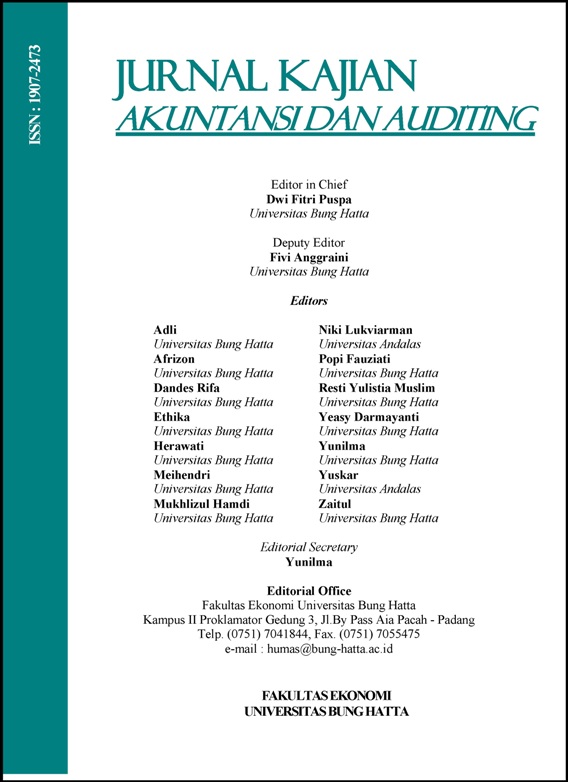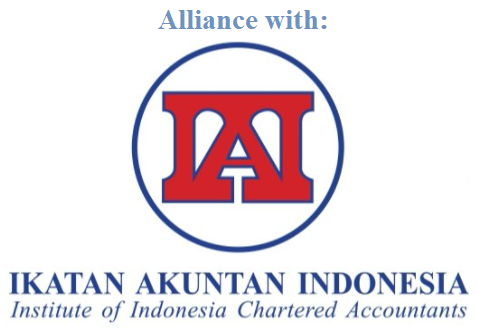Analisis Pemilihan Saham dan Tingkat Risiko terhadap Kinerja Reksa Dana Saham
DOI:
https://doi.org/10.37301/jkaa.v14i2.14Keywords:
stock selection, risk level, mutual fund performance of sharesAbstract
Mutual funds performance is one of the most important method to measure the capability of Mutual funds, this method will answer your question whether the mutual funds can be used as a good priority in investment or not. Beside that, the manager’s ability in selecting share also play the big role, since the choice that made by the manager will determine how much “return” will be received by the investors. After that, the high risk in investment, which later will show up, should be considered before taking the final decision in selecting share.This study aimed to verify the effect of share selection and the level of risk on the performance of mutual fund sharesThe data used in this study is the share of mutual funds in 2009-2011 and the samples are 18 mutual funds selected by using purposive sampling method. The data are obtained from the NAB of each fund which can be obtained at Bapepam-LK. Based on the results of hypothesis for regression models, we found out that selecting share give a great influence on Mutual funds performance and the level of risk has no significant effect on the in Mutual funds performance.
References
Darmadji, Tjiptono; dan Hendy M. Fakhruddin. 2001. Pasar Modal Indonesia :Pendekatan Tanya Jawab. Penerbit Salemba Empat : Jakarta
Dellva, W.L., De Maskey, A.L. and Smith,C.A. 2001. Selectivity and Market Timing Performance of Fidelity Sector Mutual Funds.The Financial Review,Vol.36, P 39-54.
Ekopriyo, Pratomo dan Ubadillah Nugraha, 2001, Reksadana :Solusi Perencanaan Investasi di Era Modern, Gramedia Pustaka Utama, Edisi Pertama, Jakarta.
EkoPriyo, Pratomo 2010. Reksadana: Solusi Perencanaan Investasi di Era Modern. PT. Gramedia Pustaka Utama.
Fadlul, Fotri, 2002, Uji Konsistensi antara Sharpe Ratio, Jensen Alpha danTreynor Indek Sebagai Alat Ukur Kinerja Portfolio, Tesis, MM UGM, Tidak Dipublikasikan, Yogyakarta.
Ghozali, Imam. 2011. Aplikasi Analisis Multivariate dengan Program IBM SPSS 19. Badan Penerbit Universitas Diponegoro.
Gregoriou, G.N. 2003. Performance evaluation of funds of hedge funds using conditional alphas and betas. Derivatives Use, Trading &Regulation, Vol.Eight, No.Four, Page 324-344.
Gumilang, Tinur F; dan Heru Subiyantoro. 2008. Reksa Dana Pendapatan Tetap di Indonesia: AnalisisMarket Timing dan Stock Selection Periode 2006-2008.Jurnal Keuangan dan Moneter, Badan Kebijakan Fiskal; Departemen Keuangan: Vol. 11 (1); April 2008; pp. 114-146: Jakarta.
Husnan, Suad; dan Enny Pudjiastuti. 2004. Dasar-dasar Teori Portofolio dan Analisis Sekuritas. UPP AMP YKPN : Yogyakarta
Hutagaol, Yanthi 2008. Analisis Kinerja Reksa Dana Saham Dengan Metode Raw Return, Sharpe, Treynor, Jensen Dan Sortino. Journal of Applied Finance and Accounting Vol. 1 No.1 November 2008: 193-226
Mulyana, Deden. 2006. Pengaruh Kebijakan Alokasi Aset terhadap Kinerja Reksadana Terbuka Berbentuk Kontrak Investasi Kolektif (Reksadana Saham, Reksadana Pendapatan Tetap, dan Reksadana Campuran). Jurnal Ekonomi Trikonomika; Edisi XII; No. 2 September 2006
Nurcahya, Ginting Prasetya Enka; dan Bandi. 2010. Reksadana di Indonesia :Analisis Kebijakan Alokasi Aset, Pemilihan Saham, dan Tingkat Risiko. Simposium Nasional Akuntansi, Vol XII.
Pratomo, EkoPriyo; dan Ubaidillah Nugraha. (2005). Reksa Dana: Solusi Perencanaan Investasi di Era Modern. Jakarta: PT. Gramedia Pustaka Utama.
Priyatna, Y. (2004). Analisis Perbandingan Kinerja Reksa Dana Saham dan Reksa Dana Pendapatan Tetap. Skripsi Sarjana (Tidak dipublikasikan).Yogyakarta :Fakultas Ekonomi UII.
Purnomo, CaturKuat. 2007. Pengaruh Kebijakan Alokasi Aset dan Pemilihan Sekuritas Terhadap Kinerja Reksadana Syariah. The 1st PPM National Conference on Management Research Manajemen di Era Globalisasi.Vol 1, Hal. 1
Samsul, Mohamad. 2006. Pasar modal &ManajemenPortofolio. Erlangga : Jakarta
Sari, Anindita. 2012. Analisis Kebijakan Alokasi Asset, Kinerja Manajer Investasi, dan Tingkat Risiko Terhadap Kinerja Reksadana Saham di Indonesia 2007-2011. Dipenegoro Journal Of Accounting; Vol. 1; No.1; Hal. 1-13.
Utomo, Ponco. 2010. Peluang dan Tantangan Pertumbuhan Reksa Dana di Indonesia
Widjaja, Gunawan; dan Almira Prajna Ramaniya. 2006. Reksadana dan Peran Serta Tanggung Jawab Manajer Investasi dalam Pasar Modal. Kencana : Jakarta
Widjaja, Indra; dan M.I. Waica Mahayuni. 2009. Analisis Kinerja Reksadana Fixed Income dan Hubungannya dengan Umur Reksadana. Jurnal Organisasi dan Manajemen, Tahun 11/01/Januari/2009, pp 122
Downloads
Published
Issue
Section
License
Please find the rights and licenses in Jurnal Kajian Akuntansi dan Auditing (JKAA). By submitting the article/manuscript of the article, the author(s) agree with this policy. No specific document sign-off is required.
1. License
The non-commercial use of the article will be governed by the Creative Commons Attribution license as currently displayed on Creative Commons Attribution-NonCommercial 4.0 International License.
2. Author(s)' Warranties
The author warrants that the article is original, written by stated author(s), has not been published before, contains no unlawful statements, does not infringe the rights of others, is subject to copyright that is vested exclusively in the author and free of any third party rights, and that any necessary written permissions to quote from other sources have been obtained by the author(s).
3. User/Public Rights
JKAA's spirit is to disseminate articles published are as free as possible. Under the Creative Commons Attribution-NonCommercial 4.0 International License, JKAA permits users to copy, distribute, display, and perform the work for non-commercial purposes only. Users will also need to attribute authors and JKAA on distributing works in the journal and other media of publications. Unless otherwise stated, the authors are public entities as soon as their articles got published.
4. Copyrights Holder
With the receipt of the article by Editorial Board of the Jurnal Kajian Akutansi dan Auditing (JKAA) and it was decided to be published, then the copyright regarding the article will be diverted to Jurnal Kajian Akutansi dan Auditing (JKAA).
Jurnal Kajian Akutansi dan Auditing (JKAA) hold the copyright regarding all the published articles and has the right to multiply and distribute the article under

















